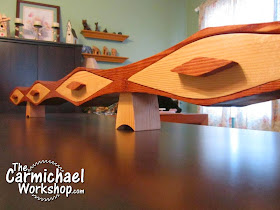I copied a set of templates from a friend a few years ago but never used them. If you would like to try to build a guitar, templates are available on the web and you can even find specs for common guitars. Just Google it!
When selecting a 2x4, I looked for one that was straight with very few defects, or at least defects that I could work around. I found one that was very straight and had a clear section that was perfect for the neck.
The 2x4 contest rules allowed for only one 8-foot 2x4 to be used. I knew it would be tough to get a guitar out of a 2x4 without running out of wood, so I had to plan my cuts carefully and conserve as much scrap as possible. I was able to complete the guitar with a small amount of scrap left in my scrap bucket.
It's easy to get bogged down in the specs and details when building a guitar, so I decided to work on a high level and stick to just enough of the basics to make it work. After all, it is just a 2x4! Aspects such as neck tension, truss rods, fingerboard action, durability, comfort, intonation, and tone took a back seat to getting the project completed by the contest deadline.
Overall the process was pretty straight-forward as far as the woodworking goes. Careful measurements and lining everything up parallel and perpendicular was important. Part of the challenge was making parts such as the nut and bridge out of wood, as these parts usually contain plastic or bone materials.
Here is my video of the 2x4 guitar build. Editing the video to be under the 10-minute limit was almost as challenging as building the guitar. Good luck to all who entered. Thank you to the sponsors for providing the prizes. And thanks to Brian at Summers Woodworking for hosting the contest!














